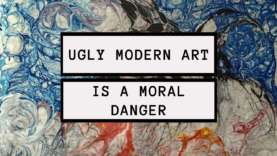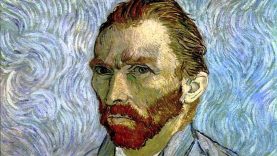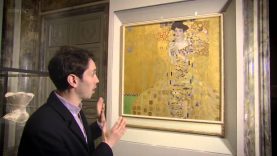Why is Modern Art so Bad?
For two millennia, great artists set the standard for beauty.
Now those standards are gone. Modern art is a competition between the ugly and the twisted; the most shocking wins.
What happened? How did the beautiful come to be reviled and bad taste come to be celebrated?
Renowned artist Robert Florczak explains the history and the mystery behind this change and how it can be stopped and even reversed.
Donate today to PragerU! http://l.prageru.com/2ylo1Yt
Joining PragerU is free! Sign up now to get all our videos as soon as they’re released. http://prageru.com/signup
Download Pragerpedia on your iPhone or Android! Thousands of sources and facts at your fingertips.
iPhone: http://l.prageru.com/2dlsnbG
Android: http://l.prageru.com/2dlsS5e
Join Prager United to get new swag every quarter, exclusive early access to our videos, and an annual TownHall phone call with Dennis Prager! http://l.prageru.com/2c9n6ys
Join PragerU’s text list to have these videos, free merchandise giveaways and breaking announcements sent directly to your phone! https://optin.mobiniti.com/prageru
Do you shop on Amazon? Click https://smile.amazon.com and a percentage of every Amazon purchase will be donated to PragerU. Same great products. Same low price. Shopping made meaningful.
VISIT PragerU! https://www.prageru.com
FOLLOW us!
Facebook: https://www.facebook.com/prageru
Twitter: https://twitter.com/prageru
Instagram: https://instagram.com/prageru/
PragerU is on Snapchat!
JOIN PragerFORCE!
For Students: http://l.prageru.com/29SgPaX
JOIN our Educators Network! http://l.prageru.com/2c8vsff
Script:
“The Mona Lisa”… “The Pieta”… “The Girl with a Pearl Earring.” For a score of centuries, artists enriched Western society with their works of astonishing beauty. “The Night Watch”… “The Thinker”… “The Rocky Mountains.” Master after master, from Leonardo, to Rembrandt, to Bierstadt, produced works that inspired, uplifted, and deepened us. And they did this by demanding of themselves the highest standards of excellence, improving upon the work of each previous generation of masters, and continuing to aspire to the highest quality attainable.
But something happened on the way to the 20th Century. The profound, the inspiring and the beautiful were replaced by the new, the different, and the ugly. Today the silly, the pointless, and the purely offensive are held up as the best of modern art.
Michelangelo carved his “David” out of a rock. The Los Angeles County Museum of Art just offers us a rock, — a rock — all 340 tons of it. That’s how far standards have fallen. How did this happen? How did the thousand-year ascent towards artistic perfection and excellence die out?
It didn’t. It was pushed out. Beginning in the late 19th century, a group dubbed The Impressionists rebelled against the French Academie des Beaux Arts and its demand for classical standards. Whatever their intentions, the new modernists sowed the seeds of aesthetic relativism — the “beauty is in the eye of the beholder” mentality.
Today everybody loves the Impressionists. And, as with most revolutions, the first generation or so produced work of genuine merit. Monet, Renoir, and Degas still maintained elements of disciplined design and execution, but with each new generation standards declined until there were no standards. All that was left was personal expression.
The great art historian Jacob Rosenberg wrote that quality in art “is not merely a matter of personal opinion but to a high degree . . . objectively traceable.” But the idea of a universal standard of quality in art is now usually met with strong resistance if not open ridicule.
“How can art be objectively measured?” I’m challenged. In responding, I simply point to the artistic results produced by universal standards compared to what is produced by relativism. The former gave the world “The Birth of Venus” and “The Dying Gaul,” while the latter has given us “The Holy Virgin Mary,” fashioned with cow dung and pornographic images, and “Petra,” the prize-winning sculpture of a policewoman squatting and urinating — complete with a puddle of synthetic urine.
Without aesthetic standards we have no way to determine quality or inferiority. Here’s a test I give my graduate students, all talented and well educated. Please analyze this Jackson Pollock painting and explain why it is good. It is only after they give very eloquent answers that I inform them that the painting is actually a close up of my studio apron. I don’t blame them; I would probably have done the same since it’s nearly impossible to differentiate between the two.
For the complete script, visit https://www.prageru.com/videos/why-modern-art-so-bad




















